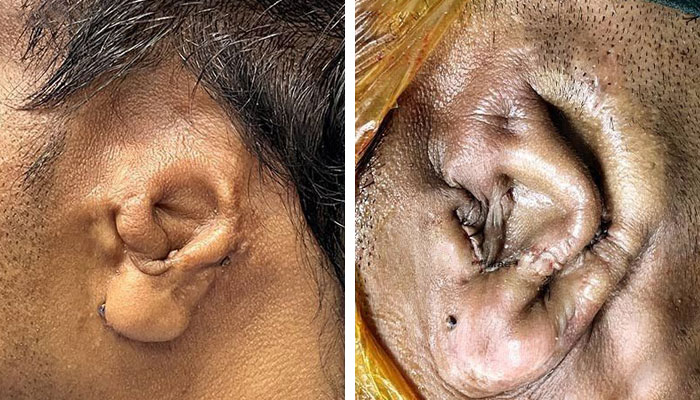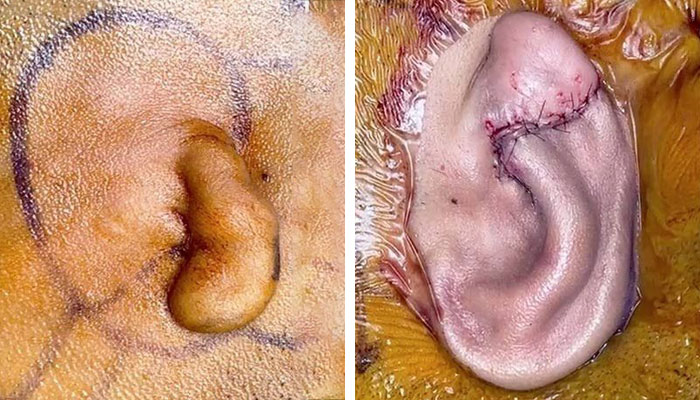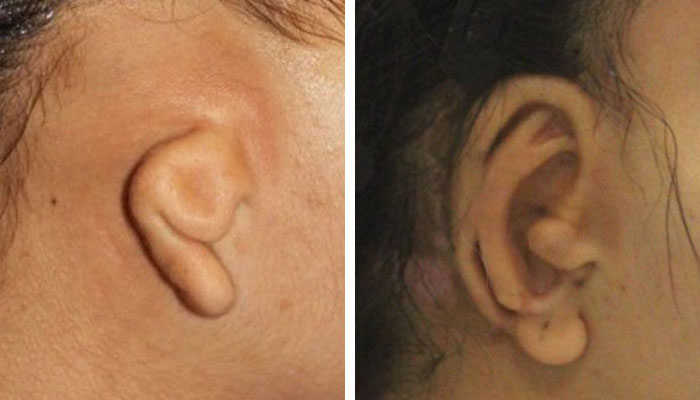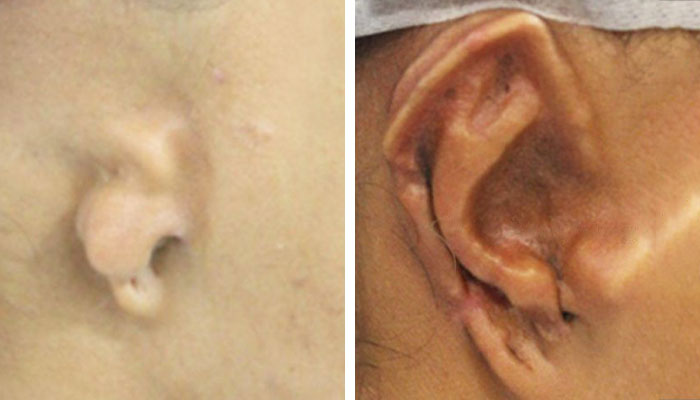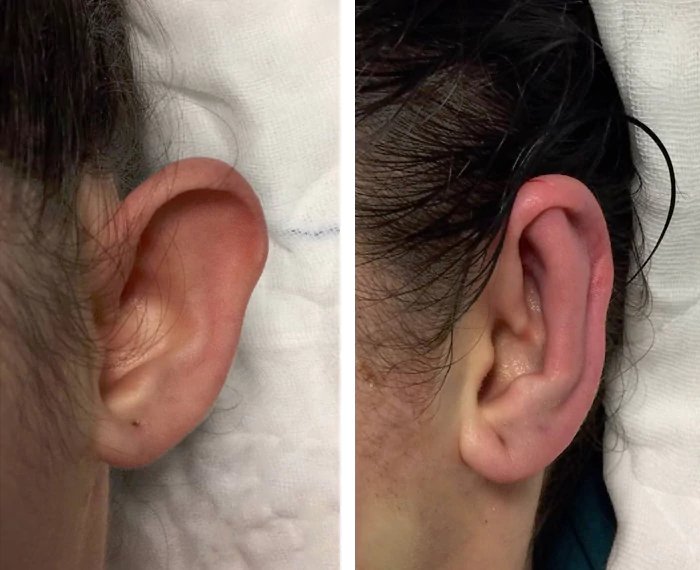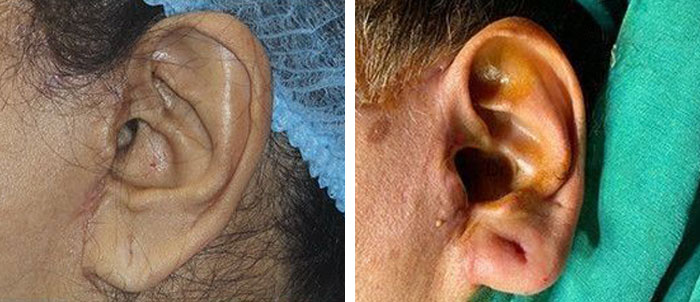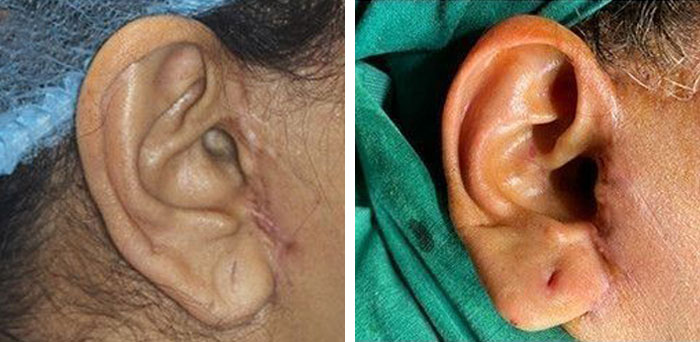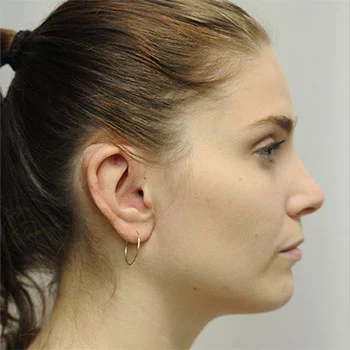What is Ear Reconstruction Surgery?
Ear reconstruction surgery, also known as auricular reconstruction, is a complex surgical procedure aimed at reconstructing or enhancing the shape, structure, and appearance of the ear. It is typically performed to address various congenital ear abnormalities, such as microtia (underdeveloped outer ear) and anotia (congenital absence of the external ear), traumatic ear injuries, or cancer-related ear deformities.
The goal of ear reconstruction surgery is to create a natural-looking and functional ear that blends harmoniously with the rest of the facial features. The specific techniques used in ear reconstruction can vary depending on the individual's condition, the extent of the deformity, and the desired outcome.
Who Are Ear Reconstruction Surgery For?
Ear reconstruction surgery is primarily intended for individuals who have congenital ear deformities, traumatic ear injuries, cancer-related ear deformities, or other congenital ear abnormalities. Here are some specific groups of individuals who may benefit from ear reconstruction surgery:
- Microtia Patients: Microtia is a congenital condition characterized by a small, underdeveloped, or malformed external ear. Ear reconstruction surgery can help create a new ear structure for individuals with microtia, enhancing their appearance and improving their self-confidence.
- Anotia Patients: Anotia, a rare congenital condition characterized by the absence of the external ear, can be treated with ear reconstruction surgery. Ear reconstruction surgery aims to create a new ear structure that closely resembles a natural ear, improving both the appearance and function of the affected ear.
- Traumatic Ear Injury Patients: Individuals who have experienced traumatic accidents resulting in ear loss or deformities may undergo ear reconstruction surgery to restore the shape and structure of their ears. This can include injuries such as ear amputations, burns, or lacerations.
- Cancer Survivors: Individuals who have undergone treatment for ear cancer, such as Mohs surgery or radiation therapy, may require ear reconstruction to restore the appearance and functionality of the ear affected by the cancer treatment.
- Congenital Ear Abnormalities: Some individuals are born with other types of ear abnormalities, such as excessively large or protruding ears, Stahl's ear (pointed or elf-like ear), or cryptotia (buried ear). Ear reconstruction surgery can help correct these abnormalities and create a more aesthetically pleasing ear shape.
It is important to note that the suitability for ear reconstruction surgery is assessed on an individual basis. Factors such as overall health, age, and personal preferences are considered during the evaluation process. A consultation with a qualified plastic surgeon or an ear reconstruction specialist is necessary to determine if someone is a suitable candidate for ear reconstruction surgery. The surgeon will evaluate the specific condition, discuss expectations, and provide personalized recommendations based on the individual's unique circumstances.
Ear Reconstruction Techniques
Ear reconstruction surgery can be performed using various techniques depending on the individual's specific condition and desired outcome. Here are some common approaches used in ear reconstruction:
Autologous Reconstruction Techniques
- Rib Cartilage Grafting: This technique involves harvesting cartilage from the patient's ribcage, typically the 6th or 7th rib. The harvested cartilage is then sculpted and shaped to create the framework of the new ear. The framework is carefully positioned and secured to the head using sutures. Skin grafts or local tissue flaps may be used to cover the cartilage framework and create a natural-looking ear.
- Medpor Implant-Based Reconstruction: In this technique, a framework made of Medpor, a porous polyethylene material, is used to recreate the ear's structure. The Medpor implant is shaped and positioned to resemble the missing or deformed ear. The implant integrates with the surrounding tissues over time, providing stability and support.
- Tissue Expansion: Tissue expansion involves the gradual stretching of nearby healthy skin to create additional tissue that can be used in ear reconstruction. A tissue expander, a balloon-like device, is placed under the skin near the ear area. Over a period of weeks or months, the expander is gradually filled with saline solution, causing the skin to stretch and grow. Once enough tissue is expanded, it is used to reconstruct the ear.
Prosthetic Reconstruction Techniques
Custom-made Ear Prostheses: For individuals who are not suitable candidates for surgical reconstruction or prefer a non-surgical option, custom-made prosthetic ears can be created. These prostheses are made to match the patient's remaining ear or desired appearance. The prosthesis is carefully fitted and attached using medical adhesives.
- Osseointegrated Hearing Devices: In some cases, ear reconstruction surgery may involve the placement of an osseointegrated hearing device. This device is surgically implanted into the bone behind the ear and can help improve hearing capabilities.
The specific surgical technique used will depend on factors such as the patient's condition, the surgeon's expertise, and the desired outcome. The procedure is typically performed under general anesthesia or local anesthesia with sedation. A thorough consultation with a plastic surgeon or ear reconstruction specialist is necessary to determine the most appropriate technique and to discuss the surgical process, potential risks, and expected recovery.
Ear Reconstruction in Young Children: When And How?
Ear reconstruction surgery in young children, particularly for conditions like microtia, requires careful consideration of the child's age, development, and individual circumstances. Here are some important factors to consider regarding the timing and approach for ear reconstruction in young children:
- Age Considerations: The optimal age for ear reconstruction surgery in young children can vary depending on the specific condition and the child's development. In the case of microtia or anotia, surgery is typically performed when the child is between the ages of 6 and 10. At this age, the child's rib cartilage has sufficiently developed, allowing for the creation of a more accurate and stable ear structure.
- Psychological and Social Factors: The decision to undergo ear reconstruction surgery in young children should also consider psychological and social factors. Children may start to become more aware of their appearance and may face challenges in social interactions due to their ear deformity. In such cases, early intervention through surgery can help improve self-esteem and overall well-being.
- Individualized Approach: Each child's case is unique, and the timing and approach for ear reconstruction surgery should be determined on an individual basis. Factors such as the severity of the deformity, the child's overall health, and the surgeon's recommendation play a crucial role in the decision-making process.
- Surgical Techniques: The surgical techniques used for ear reconstruction in young children can include autologous reconstruction using rib cartilage, tissue expansion, or Medpor implant-based reconstruction. The specific technique chosen depends on the child's condition, the surgeon's expertise, and the desired outcome. The surgeon will determine the most appropriate technique and explain the surgical process during the consultation.
- Parental Involvement and Support: Ear reconstruction in young children requires the involvement and support of parents or caregivers. They play a significant role in the decision-making process, ensuring that the child is emotionally prepared for the surgery, and providing necessary post-operative care and support during the recovery period.
It is crucial to consult with a qualified plastic surgeon or an ear reconstruction specialist who has experience in treating young children. They will evaluate the child's condition, consider various factors, and recommend the most suitable timing and approach for ear reconstruction surgery. Open communication, thorough evaluation, and a personalized approach are key to achieving successful outcomes and ensuring the well-being of the child.
How to Prepare For Surgery?
Preparing for ear reconstruction surgery involves several important steps to ensure a successful procedure and smooth recovery. Here are some general guidelines on how to prepare for the surgery:
- Consultation and Evaluation: Schedule an initial consultation with a qualified plastic surgeon or an ear reconstruction specialist. During this consultation, discuss your goals, medical history, and any concerns you may have. The surgeon will evaluate your condition, explain the surgical options, and provide personalized recommendations.
- Medical Evaluation: Before the surgery, your surgeon may request a comprehensive medical evaluation. This may include blood tests, imaging studies, and possibly a consultation with other specialists to ensure you are in good overall health for the procedure.
- Medications and Supplements: Inform your surgeon about any medications or supplements you are currently taking. Certain medications and supplements, such as blood thinners, may need to be temporarily discontinued or adjusted prior to surgery to minimize the risk of bleeding and complications.
- Smoking and Alcohol: If you smoke, it is strongly recommended to stop smoking several weeks before the surgery, as smoking can impair healing and increase the risk of complications. Similarly, it is advisable to abstain from alcohol for a few days before the surgery to promote optimal healing.
- Pre-operative Instructions: Follow any specific pre-operative instructions provided by your surgeon. This may include guidelines on fasting before the surgery, showering with a special antibacterial soap, and avoiding certain skincare products or makeup on the day of the surgery.
- Arrange Transportation and Support: Plan for someone to accompany you to the surgery and drive you home afterward, as you may be under the effects of anesthesia and unable to drive. Additionally, have someone available to assist you during the initial recovery period, as you may need help with daily activities.
- Lifestyle Adjustments: Make necessary lifestyle adjustments to promote a healthy recovery. This includes maintaining a balanced diet, staying well-hydrated, and getting sufficient rest before the surgery.
- Clothing and Comfort: On the day of the surgery, wear loose, comfortable clothing that can be easily removed and put back on after the procedure. Avoid wearing any jewelry or accessories on the surgical site.
It is important to closely follow the specific instructions provided by your surgeon, as preparation protocols may vary depending on individual circumstances. Clear communication with your surgeon and adherence to pre-operative guidelines will help ensure a successful surgical experience and optimal outcomes.
Recovery and Aftercare
The recovery and aftercare following ear reconstruction surgery are crucial for ensuring optimal healing and successful outcomes. Here are some general guidelines regarding the recovery process and aftercare for ear reconstruction:
- Hospital Stay: The length of the hospital stay after ear reconstruction surgery can vary depending on the specific procedure and individual circumstances. In some cases, it may require one or more overnight stays, while less complex procedures may allow for discharge on the same day.
- Dressings and Bandages: The surgical site will be covered with dressings and bandages to protect the incisions and support the newly reconstructed ear. It is important to follow the surgeon's instructions regarding the care and changing of dressings. Avoid touching or manipulating the area unless instructed by the surgeon or healthcare provider.
- Pain Management: Some discomfort and pain can be expected after the surgery. The surgeon may prescribe pain medications to help manage any post-operative pain. It is important to take the medications as directed and report any severe or persistent pain to the healthcare provider.
- Activity Restrictions: Following ear reconstruction surgery, it is essential to limit physical activities and avoid strenuous exercises or activities that may strain the surgical site. The surgeon will provide specific instructions on activity restrictions and when it is safe to gradually resume normal activities.
- Follow-up Appointments: Regular follow-up appointments with the surgeon will be scheduled to monitor the healing process and assess the progress of the reconstructed ear. It is important to attend these appointments as scheduled and communicate any concerns or issues with the surgeon.
- Wound Care: Proper wound care is crucial for promoting optimal healing. The surgeon will provide specific instructions on how to clean and care for the surgical site. This may involve gentle cleaning with mild soap and water, followed by the application of prescribed ointments or dressings.
- Protecting the Ear: It is important to protect the reconstructed ear from trauma and excessive pressure during the healing process. This may involve avoiding activities that could potentially harm the ear, such as contact sports or rough play. The surgeon may recommend the use of specialized headbands or protective coverings to safeguard the ear during activities.
- Psychological Support: The recovery period can be emotionally challenging, especially for children. Providing psychological support and reassurance to the patient, particularly young children, can be beneficial in promoting a positive mindset and emotional well-being.
It is crucial to closely follow the specific aftercare instructions provided by the surgeon. Every individual's recovery process may vary, and the surgeon will provide personalized guidance based on the specific procedure and individual needs. By following the recommended aftercare guidelines and attending follow-up appointments, the chances of a successful recovery and optimal outcomes can be maximized.
Risks and Complications
Like any surgical procedure, ear reconstruction surgery carries certain risks and potential complications. While complications are relatively rare, it is important to be aware of them. Here are some potential risks and complications associated with ear reconstruction surgery:
- Infection: There is a risk of developing an infection at the surgical site. This can usually be managed with antibiotics, but in some cases, additional treatment or revision surgery may be required.
- Bleeding: Excessive bleeding during or after surgery is a possible complication. Your surgeon will take precautions to minimize the risk of bleeding, but in rare cases, additional procedures may be needed to control bleeding.
- Poor Wound Healing: Some individuals may experience delayed or poor wound healing. Factors such as underlying medical conditions, smoking, or poor circulation can contribute to this complication. Following the surgeon's wound care instructions and leading a healthy lifestyle can help minimize the risk.
- Scarring: Scarring is an inherent part of any surgical procedure. The extent and visibility of scarring can vary depending on the surgical technique used and individual healing characteristics. Surgeons strive to minimize scarring by placing incisions strategically and using techniques to optimize wound closure.
- Asymmetry: Achieving perfect symmetry between the reconstructed ear and the unaffected ear can be challenging. While surgeons aim for the best possible symmetry, minor differences in size, shape, or position between the reconstructed ear and the natural ear may occur.
- Cartilage Resorption: In procedures where rib cartilage grafts are used, there is a small risk of cartilage resorption, where the body absorbs or reshapes the grafted cartilage over time. Regular follow-up appointments with the surgeon can help monitor and address any issues related to cartilage resorption if necessary.
- Anesthesia Risks: General anesthesia carries inherent risks, including allergic reactions, breathing difficulties, and medication reactions. However, these risks are generally low, and your anesthesiologist will take necessary precautions to ensure your safety.
- Dissatisfaction with Results: While most individuals are satisfied with the outcomes of ear reconstruction surgery, there is a possibility of not achieving the desired aesthetic result. It is important to have realistic expectations and to communicate your goals and concerns with your surgeon during the consultation process.
It is essential to discuss these potential risks and complications with your surgeon before undergoing ear reconstruction surgery. Your surgeon will provide you with detailed information about the specific risks related to your individual case and take necessary precautions to minimize these risks. By carefully following pre-operative and post-operative instructions and maintaining open communication with your surgeon, you can help mitigate potential complications and achieve the best possible outcomes.
Cost of Ear Reconstruction Surgery
The cost of ear reconstruction surgery can vary widely depending on several factors, including the specific procedure performed, the surgeon's experience and expertise, the geographic location of the surgical facility, and any additional costs associated with anesthesia, hospital stay, and follow-up care. It is important to note that the following information is a general guideline, and actual costs may vary.
In the United States, the average cost of ear reconstruction surgery can range from $5,000 to $20,000 or more. This cost typically includes the surgeon's fee, facility fees, anesthesia fees, and pre-operative and post-operative care. However, it is important to inquire about the specific breakdown of costs with your surgeon or their office to get a clearer understanding of what is covered in the overall cost.
Factors that can influence the cost of ear reconstruction surgery include the complexity of the procedure, surgeon’s experience and reputation, geographic location, and additional services such as imaging studies, laboratory tests, post-operative medications, and follow-up care.
It is important to consult with a qualified plastic surgeon or an ear reconstruction specialist to discuss your specific needs and receive an accurate estimate of the costs associated with ear reconstruction surgery. Additionally, check with your insurance provider to determine if any portion of the expenses may be covered under your insurance policy.

